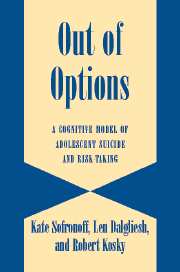Book contents
- Frontmatter
- Contents
- Preface
- Introduction
- 1 Adolescent Suicide: An Overview of the Epidemiology
- 2 Risk and Predisposing Factors in Adolescent Suicide
- 3 Emotional Problems and Adolescent Suicide
- 4 Adolescent Suicide: Cognitive Variables
- ADOLESCENT RISK-TAKING
- A MODEL OF SUICIDE AND RISK-TAKING
- AN EVALUATION OF THE S/RT MODEL
- IMPLICATIONS FOR TREATMENT
- References
- Index
1 - Adolescent Suicide: An Overview of the Epidemiology
Published online by Cambridge University Press: 03 September 2009
- Frontmatter
- Contents
- Preface
- Introduction
- 1 Adolescent Suicide: An Overview of the Epidemiology
- 2 Risk and Predisposing Factors in Adolescent Suicide
- 3 Emotional Problems and Adolescent Suicide
- 4 Adolescent Suicide: Cognitive Variables
- ADOLESCENT RISK-TAKING
- A MODEL OF SUICIDE AND RISK-TAKING
- AN EVALUATION OF THE S/RT MODEL
- IMPLICATIONS FOR TREATMENT
- References
- Index
Summary
Epidemiology
Epidemiological studies indicate that suicide is a leading cause of death among adolescents throughout the industrialized world. The rate of suicide among adolescents increased dramatically over the last part of the 20th century, and this increase is of the greatest concern to the community. In the United States of America, the overall rate of suicide has remained steady but the mean age of those committing suicide has decreased. The rate at which young people commit suicide has risen dramatically (see Table 1). This trend is mirrored in Australia, where the overall rate of suicide for 15- to 24-year-olds is 16.4 per 100,000, among the highest in the industrialized world (UNICEF, 1993).
Age and Gender
The suicide rate among male adolescents, aged 15–19 years, is particularly alarming. In Australia, the Australian Bureau of Statistics (1995) reported a fourfold increase between 1960 and 1995 in suicides for young males. In 1960, 50 males between the ages of 15 and 24 committed suicide, representing a rate of 6.8 per 100,000 of the general population. By 1994 this had increased to 384, or a rate of 27 per 100,000. Female suicides are significantly less common than male suicides (approximately 1:5; Leslie, Stein, & Rotheram-Borus, 2002).
These trends are seen across the world. Figures 1.1 through 1.5 illustrate both the gender discrepancy in suicide and the increase in adolescent rates in a selection of countries. The statistics are the most recent available and were obtained from the World Health Organization, Geneva, 2000.
- Type
- Chapter
- Information
- Out of OptionsA Cognitive Model of Adolescent Suicide and Risk-Taking, pp. 11 - 16Publisher: Cambridge University PressPrint publication year: 2004



